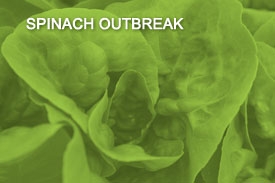Home
»
News
»
Narratives of One Health In Action
Spinach Outbreak
11/21/2011
One Health collaboration can help prevent food-borne illness
 The Centers for Disease Control and Prevention (CDC) estimates that 76 million people get sick, more than 300,000 are hospitalized, and 5,000 Americans die each year from food-borne illnesses. Preventing food-borne illness is a major public health challenge.
The Centers for Disease Control and Prevention (CDC) estimates that 76 million people get sick, more than 300,000 are hospitalized, and 5,000 Americans die each year from food-borne illnesses. Preventing food-borne illness is a major public health challenge.
An outbreak of E. coli O157:H7 was first noted on September 8, 2006 when CDC officials were alerted by epidemiologists in Wisconsin of a small cluster of E. coli O157:H7 infections of unknown source. The epidemiologists also determined the “DNA fingerprint” pattern of the cluster. Separately, the state health department of Oregon noted a very small cluster of infections that day and began an investigation. On September 13, both Wisconsin and Oregon reported to CDC that eating fresh spinach was commonly reported in both clusters of E. coli O157:H7 infections in those states. The DNA fingerprint patterns in the two clusters were identical, and other states reported cases with the same pattern among ill persons who also had eaten fresh spinach. CDC notified the US Food and Drug Administration (FDA) about the Wisconsin and Oregon cases and the possible link with bagged fresh spinach.
Quick sharing of information among the states led to warning the public not to eat fresh bagged spinach. Further investigation indicated that the outbreak was associated with bagged spinach produced under multiple labels in a single plant on a single day during a single shift. Epidemiological investigations identified the environmental risk factors and the areas that were most likely involved in the outbreak. Potential environmental risk factors for E.coli O157:H7 contamination at or near the field included the presence of wild pigs, the proximity of irrigation wells used to grow produce for ready-to-eat packaging, and surface waterways exposed to feces from cattle and wildlife.
The outbreak of E. coli O157 infections from the contaminated spinach illustrates how a large and widespread outbreak can occur, appearing first as small clusters, and then rapidly increasing if a popular commercial product is contaminated.
Produce-related outbreaks are a growing challenge to public health. As this and other outbreaks indicate, research needs to focus on tracing the specific pathways that connect fields of leafy green vegetables with potential animal reservoirs of E. coli and other microbes that cause food-borne human disease.





 The Centers for Disease Control and Prevention (CDC) estimates that 76 million people get sick, more than 300,000 are hospitalized, and 5,000 Americans die each year from food-borne illnesses. Preventing food-borne illness is a major public health challenge.
The Centers for Disease Control and Prevention (CDC) estimates that 76 million people get sick, more than 300,000 are hospitalized, and 5,000 Americans die each year from food-borne illnesses. Preventing food-borne illness is a major public health challenge.